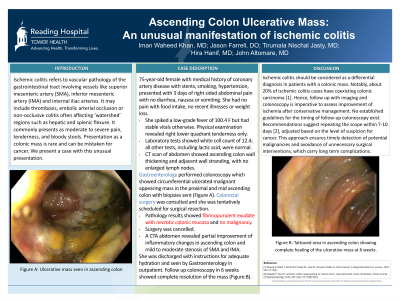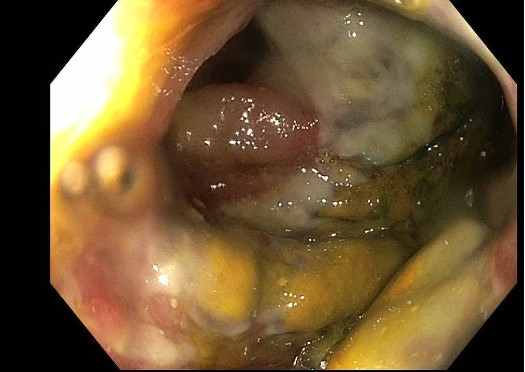Sunday Poster Session
Category: Colon
P0277 - Ascending Colon Ulcerative Mass: An Unusual Manifestation of Ischemic Colitis
Sunday, October 27, 2024
3:30 PM - 7:00 PM ET
Location: Exhibit Hall E

Has Audio

Iman Khan, MD
Reading Hospital - Tower Health
Reading, PA
Presenting Author(s)
Iman Waheed Khan, MD, Jason Farrell, DO, Tirumala Nischal Jasty, MD, Hira Hanif, MD, John Altomare, MD
Reading Hospital - Tower Health, Reading, PA
Introduction: Ischemic colitis refers to vascular pathology of the gastrointestinal tract involving vessels like superior mesenteric artery (SMA), inferior mesenteric artery (IMA) and internal iliac arteries. It may include thrombosis, embolic arterial occlusion or non-occlusive colitis often affecting ‘watershed’ regions such as hepatic and splenic flexure. It commonly presents as moderate to severe pain, tenderness, and bloody stools. Presentation as a colonic mass is rare and can be mistaken for cancer. We present a case with this unusual presentation.
Case Description/Methods: 75-year-old female with medical history of coronary artery disease with stents, smoking, hypertension, presented with 3 days of right sided abdominal pain with no diarrhea, nausea or vomiting. She had no pain with food intake, no recent illnesses or weight loss. She spiked a low-grade fever of 100.4 F but stable vitals. Physical examination revealed right lower quadrant tenderness only. Laboratory tests showed white cell count of 12.4; all other tests, including lactic acid, were normal. CT scan of abdomen showed ascending colon wall thickening and adjacent wall stranding, with no enlarged lymph nodes. Gastroenterology performed colonoscopy which showed circumferential ulcerated malignant appearing mass in the proximal and mid ascending colon with biopsies sent. Colorectal surgery was consulted and she was tentatively scheduled for surgical resection. Pathology results showed fibrinopurulent exudate with necrotic colonic mucosa and no malignancy. Surgery was cancelled. A CTA abdomen revealed partial improvement of inflammatory changes in ascending colon and mild to moderate stenosis of SMA and IMA. She was discharged with instructions for adequate hydration and seen by Gastroenterology in outpatient. Follow up colonoscopy in 6 weeks showed complete resolution of the mass.
Discussion: Ischemic colitis should be considered as a differential diagnosis in patients with a colonic mass. Notably, about 20% of ischemic colitis cases have coexisting colonic carcinoma [1]. Hence, follow up with imaging and colonoscopy is imperative to assess improvement of ischemia after conservative management. No established guidelines for the timing of follow-up colonoscopy exist. Recommendations suggest repeating the scope within 7-10 days [2], adjusted based on the level of suspicion for cancer. This approach ensures timely detection of potential malignancies and avoidance of unnecessary surgical interventions, which carry long term complications.

Disclosures:
Iman Waheed Khan, MD, Jason Farrell, DO, Tirumala Nischal Jasty, MD, Hira Hanif, MD, John Altomare, MD. P0277 - Ascending Colon Ulcerative Mass: An Unusual Manifestation of Ischemic Colitis, ACG 2024 Annual Scientific Meeting Abstracts. Philadelphia, PA: American College of Gastroenterology.
Reading Hospital - Tower Health, Reading, PA
Introduction: Ischemic colitis refers to vascular pathology of the gastrointestinal tract involving vessels like superior mesenteric artery (SMA), inferior mesenteric artery (IMA) and internal iliac arteries. It may include thrombosis, embolic arterial occlusion or non-occlusive colitis often affecting ‘watershed’ regions such as hepatic and splenic flexure. It commonly presents as moderate to severe pain, tenderness, and bloody stools. Presentation as a colonic mass is rare and can be mistaken for cancer. We present a case with this unusual presentation.
Case Description/Methods: 75-year-old female with medical history of coronary artery disease with stents, smoking, hypertension, presented with 3 days of right sided abdominal pain with no diarrhea, nausea or vomiting. She had no pain with food intake, no recent illnesses or weight loss. She spiked a low-grade fever of 100.4 F but stable vitals. Physical examination revealed right lower quadrant tenderness only. Laboratory tests showed white cell count of 12.4; all other tests, including lactic acid, were normal. CT scan of abdomen showed ascending colon wall thickening and adjacent wall stranding, with no enlarged lymph nodes. Gastroenterology performed colonoscopy which showed circumferential ulcerated malignant appearing mass in the proximal and mid ascending colon with biopsies sent. Colorectal surgery was consulted and she was tentatively scheduled for surgical resection. Pathology results showed fibrinopurulent exudate with necrotic colonic mucosa and no malignancy. Surgery was cancelled. A CTA abdomen revealed partial improvement of inflammatory changes in ascending colon and mild to moderate stenosis of SMA and IMA. She was discharged with instructions for adequate hydration and seen by Gastroenterology in outpatient. Follow up colonoscopy in 6 weeks showed complete resolution of the mass.
Discussion: Ischemic colitis should be considered as a differential diagnosis in patients with a colonic mass. Notably, about 20% of ischemic colitis cases have coexisting colonic carcinoma [1]. Hence, follow up with imaging and colonoscopy is imperative to assess improvement of ischemia after conservative management. No established guidelines for the timing of follow-up colonoscopy exist. Recommendations suggest repeating the scope within 7-10 days [2], adjusted based on the level of suspicion for cancer. This approach ensures timely detection of potential malignancies and avoidance of unnecessary surgical interventions, which carry long term complications.

Figure: Ulcerative mass seen in ascending colon
Disclosures:
Iman Waheed Khan indicated no relevant financial relationships.
Jason Farrell indicated no relevant financial relationships.
Tirumala Nischal Jasty indicated no relevant financial relationships.
Hira Hanif indicated no relevant financial relationships.
John Altomare indicated no relevant financial relationships.
Iman Waheed Khan, MD, Jason Farrell, DO, Tirumala Nischal Jasty, MD, Hira Hanif, MD, John Altomare, MD. P0277 - Ascending Colon Ulcerative Mass: An Unusual Manifestation of Ischemic Colitis, ACG 2024 Annual Scientific Meeting Abstracts. Philadelphia, PA: American College of Gastroenterology.
